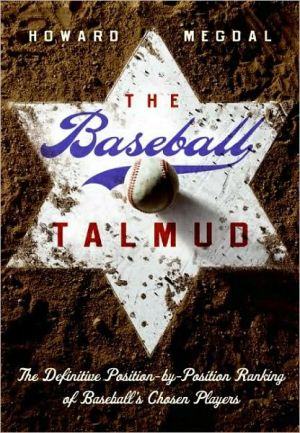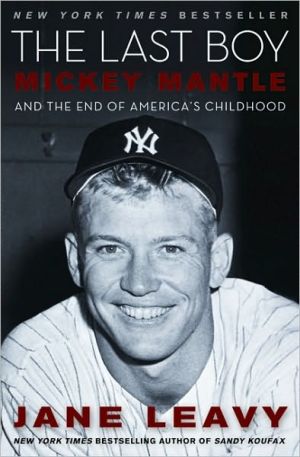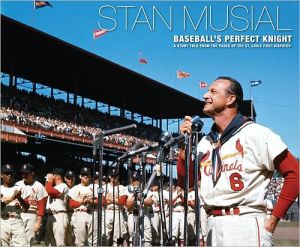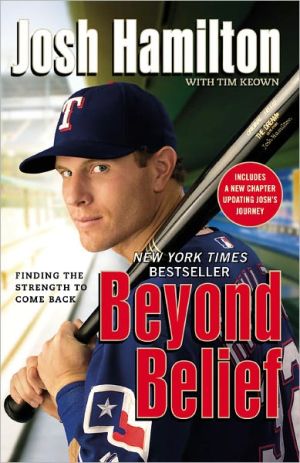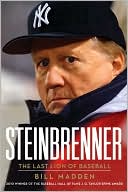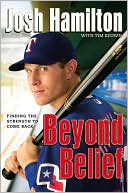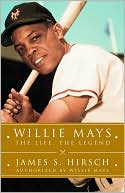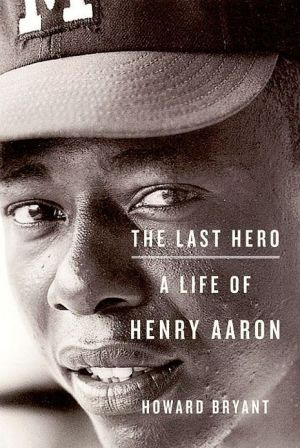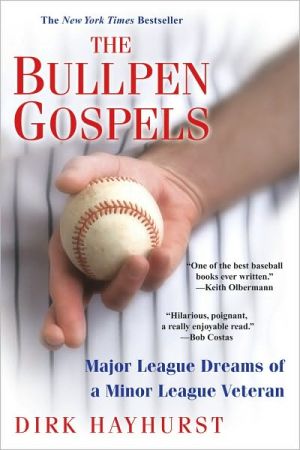The Baseball Talmud
From the icons of the game to the players who got their big break but never quite broke through, The Baseball Talmud provides a wonderful historical narration of Major League Jewish Baseball in America. All the stats, the facts, the stories, and the (often unheralded) glory.\ The Baseball Talmud reveals that there is far more to Jewish baseball than Hank Greenberg's powerful slugging and Sandy Koufax's masterful control. From Ausmus to Zinn, Berg to Kinsler, Holtzman to Yeager, and many...
Search in google:
From the icons of the game to the players who got their big break but never quite broke through, The Baseball Talmud provides a wonderful historical narration of Major League Jewish Baseball in America. All the stats, the facts, the stories, and the (often unheralded) glory. The Baseball Talmud reveals that there is far more to Jewish baseball than Hank Greenberg's powerful slugging and Sandy Koufax's masterful control. From Ausmus to Zinn, Berg to Kinsler, Holtzman to Yeager, and many others, Megdal draws upon the lore and the little-known details that increase our enjoyment of the game, including: Which Jewish player spent a portion of his retirement as a spy Who received $50,000 and a car to quit school and join the Major Leagues How many players sat out of games scheduled on Yom Kippur Which famous player chose baseball over becoming a rabbi But this is more than just stories. Megdal, a stat geek himself, uses the wealth of modern sabermetrics to determine the greatest Jewish players at each position, the all-time Jewish All-Star Team, and how they would rate against the greatest teams in baseball history, from the 1906 Chicago Cubs to the 1998 New York Yankees. The Baseball Talmud rewrites the history of Jewish baseball and is a book that every baseball fan should own.
The Baseball Talmud\ Chapter One\ The Greatest Jewish Baseball Player\ 1. Hank Greenberg\ There is broad consensus on who the two best Jewish players in major league history are—Hank Greenberg and Sandy Koufax. But the confusion over which player is the best is perfectly understandable—the two performances are very close, and while the players played two very different positions, their careers mirror each other.\ Greenberg was a power-hitting first baseman in the best offensive era in baseball history, the 1930s. Koufax was a power pitcher in the best pitching era in baseball history, the 1960s. Greenberg's career numbers were limited by World War II. Koufax's career numbers were limited by injury that caused his retirement at age 30.\ So how do we go about determining which elite player is better? Baseball Prospectus's WARP3, which determines season value in terms of wins over a replacement-level player, adjusted for park and era, is an important tool. Through this metric, we see that Koufax put up a career total of 68.3 wins over replacement player in 12 seasons, with his first 6 seasons totaling 13.9 wins, and his final 6 seasons totaling 54.4 wins.\ Greenberg, meanwhile was at 77.0 wins in his career over 12 seasons (plus one at bat in 1930). Greenberg was a valuable player from the start and posted a season of eight wins in 1934, his second full year, at age 23. So for a greater portion of his career, Greenberg was an elite player.\ But the question becomes, was Koufax better in his prime to balance things out? The answer is: not really. Match up their best seasons, and you get thefollowing:\ Koufax: 11.9, 10.6, 10.3, 8.2, 7.7, 5.7, 3.7, 3.5\ Greenberg: 10.5, 9.8, 9.7, 9.6, 9.2, 8.0, 6.6, 5.5\ While Koufax's 1966 stands a bit above anything Greenberg did, the next few best seasons are pretty indistinguishable—and Greenberg simply had more of them.\ 2. Sandy Koufax\ There is, amazingly enough, a statistical argument to be made for Lou Boudreau over Sandy Koufax. But there are a couple of factors that make me discount the edge Boudreau would have.\ Boudreau's WARP3 values are astounding—he had a 15.7 WARP3 in 1948, his signature season. And this was not as flukish as you'd expect—he also posted seasons at 12.1, 12.0, 12.0, and 11.8. His career total of 110.1 dwarfs Koufax's 68.3.\ But this total is built on a pair of adjustments I simply can't buy. One is giving Boudreau enormous credit for playing in Cleveland Stadium. Baseball Prospectus takes his career line of.295/.380/.415 (batting average/on-base percentage/slugging percentage) and inflates it to.301/.376/.479. The power numbers, in particular, look suspect to me—Cleveland Stadium was a pitcher's park, but not to that extreme. Baseball-Reference.com neutralizes Boudreau's line to an improved.299/.385/.420—better, but not ludicrously so.\ His WARP3 is also inflated by tremendous fielding stats—Baseball Prospectus has him saving 161 runs over replacement in his career. Now, fielding stats are still improving in legitimacy for current players, where we have real-time play-by-play to evaluate each player by computerized zones. Still, there are holes in the data. The '40s defensive stats? Not even close. So I'm supposed to buy into Boudreau saving nearly 100 more runs in his career than Omar Vizquel, who is at 69? I just can't credit him with all of that.\ Put him in a more appropriate context, and Boudreau is still a Hall of Famer, a very valuable player. But he pales in comparison to Koufax, whose dominance is unquestioned and whose strikeouts are completely verifiable.\ 3. Lou Boudreau\ Now Boudreau, according to Baseball Prospectus, put up an EQA (offensive production expressed as an average) of.290. That ties him with Shawn Green, who also posted an EQA of.290. Green also did so in a career approximately 14 percent longer—7,082 at bats for Green to 6,029 at bats for Boudreau.\ But Boudreau holds the edge for several reasons. For one thing, Boudreau was an elite player for a larger portion of his career. Green's best seasons all came between the ages of 26 and 30; Boudreau had Hall of Fame seasons between the ages of 22 and 30.\ Another edge is positional. Green was, for much of his career, a good outfielder. But that value simply pales in comparison to the value of a good shortstop. While it is reasonable to speculate about the true level of Boudreau's defensive contributions, no one has suggested that he wasn't an elite defensive shortstop. When the two players are similar offensively—Boudreau and Green also had identical career OPS+ marks (on-base percentage plus slugging percentage adjusted for era and park, and expressed relative to average) of 120—the tie has to go to the shortstop.\ 4. Shawn Green\ I am tempted to say Green holds the advantage over Buddy Myer simply because he reads Eastern philosophy—indeed, my conversation with Green about the philosophical treatise Siddartha in 2007 was my only time discussing the book in a major league clubhouse, though in fairness to other players, I rarely bring it up.\ But Green in fact holds an edge for his contributions on the field: his.290 EQA and 120 OPS+ are considerably ahead of Buddy Myer's.273 and 108, respectively.\ Injuries really kept Green from the upper-tier discussion—in his three best seasons, he posted WARP3 marks of 11.8, 11.3, and 9.8, with plus defensive marks in all three seasons.\ 5. Buddy Myer\ For Myer, a combination of consistency and longevity places him in the top five, even though Al Rosen is better known. Such is the case when in the shadow of home run hitters.\ There is little question that, at his best, Rosen was a better player than Myer—OPS+ edge of 137 to 108, EQA of.302 to.273. But Rosen, limited by back problems, had just 3,725 career at bats, while Myer was at 7,038.\ To rank Rosen above Myer, it would be necessary to come to the conclusion that Rosen was twice the player Myer was. And there's just not evidence enough to support that.\ The Baseball Talmud. Copyright © by Howard Megdal. Reprinted by permission of HarperCollins Publishers, Inc. All rights reserved. Available now wherever books are sold.
\ Jeremy Schaap“In the spirit of a lavish bar mitzvah, The Baseball Talmud skimps on nothing. They’re all here—the greats, the unknowns, the descendants of Abraham and the recently converted. This is the book Bill James would have written—if he were Jewish.”\ \ \ \ \ John Eisenberg“What is there to say about a book that, among its many merits, invents the “value-added Judaism” statistic? With high humor and a strong grasp of his facts, Howard Megdal answers questions and addresses issues that Jewish fans have long wondered about—and fans of other faiths will also enjoy.”\ \ \ L. Jon Wertheim“Howard Megdal’s witty and informative book gives the definitive rabbinic commentary on the 160—Who knew?—Jews who played in the Major Leagues. These guys could pitch, field and hit. Plus, they loved their mothers.”\ \
